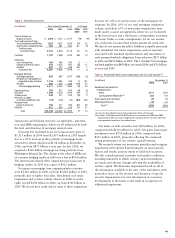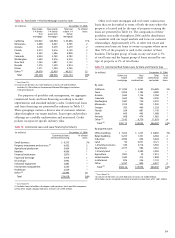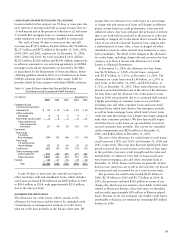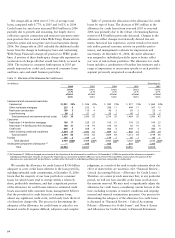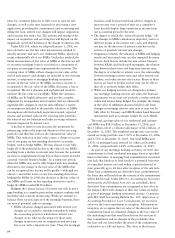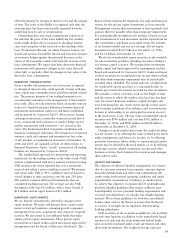Wells Fargo 2006 Annual Report Download - page 52
Download and view the complete annual report
Please find page 52 of the 2006 Wells Fargo annual report below. You can navigate through the pages in the report by either clicking on the pages listed below, or by using the keyword search tool below to find specific information within the annual report.
50
Our business units and the office of the Chief Credit
Officer periodically review all credit risk portfolios to ensure
that the risk identification processes are functioning properly
and that credit standards are followed. Business units con-
duct quality assurance reviews to ensure that loans meet
portfolio or investor credit standards. Our loan examiners
and internal auditors also independently review portfolios
with credit risk.
Our primary business focus on middle-market commercial
and residential real estate, auto and small consumer lending,
results in portfolio diversification. We assess loan portfolios
for geographic, industry or other concentrations and use
mitigation strategies, which may include loan sales, syndica-
tions or third party insurance, to minimize these concentra-
tions, as we deem appropriate.
In our commercial loan, commercial real estate loan and
lease financing portfolios, larger or more complex loans are
individually underwritten and judgmentally risk rated. They
are periodically monitored and prompt corrective actions are
taken on deteriorating loans. Smaller, more homogeneous
commercial small business loans are approved and moni-
tored using statistical techniques.
Retail loans are typically underwritten with statistical
decision-making tools and are managed throughout their life
cycle on a portfolio basis. The Chief Credit Officer establishes
corporate standards for model development and validation to
ensure sound credit decisions and regulatory compliance and
approves new model implementation and periodic validation.
Residential real estate mortgages are one of our core
products. We offer a broad spectrum of first mortgage and
junior lien loans that we consider predominantly prime or
near prime. These loans are almost entirely secured by a
primary residence for the purpose of purchase money,
refinance, debt consolidation, or home equity loans. We
do not believe negative amortization or option ARMs
benefit our customers and have not made or purchased
these loan products.
We originate mortgage loans through a variety of sources,
including our retail sales force, licensed real estate brokers
and correspondent lenders. We apply consistent credit poli-
cies, borrower documentation standards, Federal Deposit
Insurance Corporation Improvement Act of 1991 (FDICIA)
compliant appraisal requirements, and sound underwriting,
regardless of application source. We perform quality control
reviews for third party originated loans and actively manage
or terminate sources that do not meet our credit standards.
We believe our underwriting process is well controlled
and appropriate for the needs of our customers. We offer
interest-only products but ensure that the customer qualifies
for higher payments after the initial interest-only period. The
majority of our reduced documentation loans are initiated
based on our determination that the customer is creditworthy
without having to supply unnecessary paperwork. Appraisals
are ordered and reviewed independently to ensure supportable
property values. We obtain mortgage insurance on higher
loan-to-value first mortgage loans, and monitor regional
economic and real estate trends modifying underwriting
standards as needed.
We continue to be among the highest rated loan servicers
for prime and non-prime residential real estate mortgage loans.
High quality servicing improves customer service and has been
demonstrated to result in lower foreclosures and losses.
Each business unit completes quarterly asset quality
forecasts to quantify its intermediate-term outlook for loan
losses and recoveries, nonperforming loans and market trends.
To make sure our overall loss estimates and the allowance
for credit losses is adequate, we conduct periodic stress tests.
This includes a portfolio loss simulation model that simulates
a range of possible losses for various sub-portfolios assuming
various trends in loan quality, stemming from economic
conditions or borrower performance.
We routinely review and evaluate risks that are not
borrower specific but that may influence the behavior of
a particular credit, group of credits or entire sub-portfolios.
We also assess risk for particular industries, geographic
locations such as states or Metropolitan Statistical Areas
(MSAs) and specific macroeconomic trends.
LOAN PORTFOLIO CONCENTRATIONS
Loan concentrations may exist when there are borrowers
engaged in similar activities or types of loans extended to a
diverse group of borrowers that could cause those borrowers
or portfolios to be similarly impacted by economic or other
conditions.
The concentrations of real estate 1-4 family mortgage
loans by state are presented in Table 12. Our real estate 1-4
family mortgage loans to borrowers in the state of California
represented approximately 11% of total loans at December 31,
2006, compared with 14% at the end of 2005. These loans
are mostly within the larger metropolitan areas in California,
with no single area consisting of more than 3% of our total
loans. Changes in real estate values and underlying economic
or market conditions for these areas are monitored continu-
ously within the credit risk management process.
Some of our real estate 1-4 family mortgage loans, includ-
ing first mortgage and home equity products, include an
interest-only feature as part of the loan terms. At December 31,
2006, these loans were approximately 19% of total loans,
compared with 26% at the end of 2005. Substantially all of
these loans are considered to be prime or near prime. We do
not offer option adjustable-rate mortgage products, nor do
we offer variable-rate mortgage products with fixed payment
amounts, commonly referred to within the financial services
industry as negative amortizing mortgage loans.







